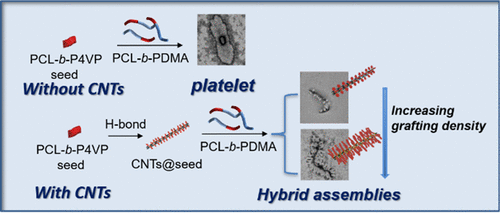当前位置:
X-MOL 学术
›
Macromolecules
›
论文详情
Our official English website, www.x-mol.net, welcomes your
feedback! (Note: you will need to create a separate account there.)
Spatially Restricted Templated Growth of Poly(ε-caprolactone) from Carbon Nanotubes by Crystallization-Driven Self-Assembly
Macromolecules ( IF 5.1 ) Pub Date : 2021-03-05 , DOI: 10.1021/acs.macromol.0c02739 Zaizai Tong 1, 2 , Yawei Su 1, 2 , Yikun Jiang 1 , Yujie Xie 3 , Shichang Chen 1 , Rachel K. O’Reilly 3
Macromolecules ( IF 5.1 ) Pub Date : 2021-03-05 , DOI: 10.1021/acs.macromol.0c02739 Zaizai Tong 1, 2 , Yawei Su 1, 2 , Yikun Jiang 1 , Yujie Xie 3 , Shichang Chen 1 , Rachel K. O’Reilly 3
Affiliation

|
The fabrication of hybrid hierarchical assemblies involving inorganic and organic building blocks has received a significant amount of attention as a result of their facile tunability and potential applications. However, precise design of hybrid hierarchical architectures still remains a challenge because of the difficulty of precise control over design and the incompatibility of organic and inorganic building blocks. Crystallization-driven self-assembly (CDSA) of block copolymers is a powerful method in the preparation of complex semicrystallized structures from the nano- to microscale, with controlled shape and uniform size. Herein, we extended the scope of this methodology in the construction of hybrid micellar CDSA brushes on functionalized carbon nanotubes (CNTs). Tunable brushlike heterostructures containing both CNTs and CDSA nanoassemblies were fabricated by anchoring the short crystalline seeds of PCL-b-P4VP [PCL = poly(ε-caprolactone) and P4VP = poly(4-vinylpyridine)] onto CNTs through the hydrogen bond and by a further in situ CDSA process via the addition of PCL-b-PDMA [PDMA = poly(N,N-dimethylacrylamide)] unimers. More importantly, the shapes of PCL-b-PDMA crystals changed from two-dimensional platelets to long and thin crystals with increasing mass ratios of seed micelles to CNTs. Moreover, further exploration indicated that only one end of the immobilized seeds could initiate the growth of PCL-b-PDMA crystals, while the other end failed to enable growth because of the spatial confinement of CNTs.
中文翻译:

通过结晶驱动的自组装从碳纳米管中受空间限制的模板化生长聚(ε-己内酯)
由于它们的易用性和潜在的应用,涉及无机和有机构件的混合分层组件的制造已经引起了广泛的关注。但是,由于对设计进行精确控制的困难以及有机和无机构建基块的不兼容,混合分层体系结构的精确设计仍然是一个挑战。嵌段共聚物的结晶驱动自组装(CDSA)是制备从纳米级到微米级,形状可控且尺寸均匀的复杂半结晶结构的有力方法。本文中,我们在功能化碳纳米管(CNT)上构建混合胶束CDSA刷时扩展了该方法的范围。b- P4VP [PCL =聚(ε-己内酯),P4VP =聚(4-乙烯基吡啶)]通过氢键并通过原位CDSA工艺通过添加PCL- b -PDMA [PDMA = poly(N,N-二甲基丙烯酰胺)]单体。更重要地,随着种子胶束与CNT的质量比增加,PCL- b- PDMA晶体的形状从二维片晶变为长而薄的晶体。此外,进一步的研究表明,固定化种子的仅一端可以启动PCL- b -PDMA晶体的生长,而另一端由于碳纳米管的空间限制而无法生长。
更新日期:2021-03-23
中文翻译:

通过结晶驱动的自组装从碳纳米管中受空间限制的模板化生长聚(ε-己内酯)
由于它们的易用性和潜在的应用,涉及无机和有机构件的混合分层组件的制造已经引起了广泛的关注。但是,由于对设计进行精确控制的困难以及有机和无机构建基块的不兼容,混合分层体系结构的精确设计仍然是一个挑战。嵌段共聚物的结晶驱动自组装(CDSA)是制备从纳米级到微米级,形状可控且尺寸均匀的复杂半结晶结构的有力方法。本文中,我们在功能化碳纳米管(CNT)上构建混合胶束CDSA刷时扩展了该方法的范围。b- P4VP [PCL =聚(ε-己内酯),P4VP =聚(4-乙烯基吡啶)]通过氢键并通过原位CDSA工艺通过添加PCL- b -PDMA [PDMA = poly(N,N-二甲基丙烯酰胺)]单体。更重要地,随着种子胶束与CNT的质量比增加,PCL- b- PDMA晶体的形状从二维片晶变为长而薄的晶体。此外,进一步的研究表明,固定化种子的仅一端可以启动PCL- b -PDMA晶体的生长,而另一端由于碳纳米管的空间限制而无法生长。











































 京公网安备 11010802027423号
京公网安备 11010802027423号